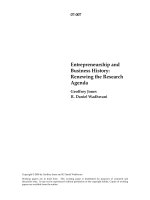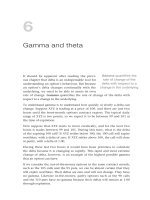The dumbest moments in business history useless products ruinous deals clueless bosses and other signs of unintelligent life in the workplace by adam horowitz
Bạn đang xem bản rút gọn của tài liệu. Xem và tải ngay bản đầy đủ của tài liệu tại đây (722.11 KB, 169 trang )
PORTFOLIO
THE
DUMBEST
MOMENTS
BUSINESS
HISTORY
IN
Adam Horowitz is the deputy editor of Business 2.0 and a
creator of "The 101 Dumbest Moments in Business," one of
the magazine's most popular annual features. He and his fellow
editors are based in San Francisco. Which is good, because a
number of restaurants in his former home of Santa Fe—in not¬
at-all-dumb moments of business judgment—have banned
him for publicly ridiculing their shortcomings.
Visit Business 2.0 online at www.business2.com.
The Dumbest Moments
in Business History
USELESS PRODUCTS,
RUINOUS DEALS,
CLUELESS BOSSES
AND OTHER SIGNS OF
UNINTELLIGENT LIFE IN THE
WORKPLACE
Adam Horowitz
and the Editors of Business 2.0
Compiled by Mark Athitakis
and Mark Lasswell
PORTFOLIO
Published by the Penguin Group
Penguin Group (USA) Inc., 375 Hudson Street, New York, New York 10014, U.S.A.
Penguin Group (Canada), 10 Alcorn Avenue.Toronto, Ontario, Canada M4V 3B2
(a division of Pearson Penguin Canada Inc.)
Penguin Books Ltd, 80 Strand, London WC2R ORL, England
Penguin Ireland, 25 St Stephen's Green, Dublin 2, Ireland
(a division of Penguin Books Ltd)
Penguin Group (Australia), 250 Camberwell Road, Camberwell,
Victoria 3124, Australia (a division of Pearson Australia Group Pty Ltd)
Penguin Books India Pvt Ltd, 11 Community Centre,
Panchsheel Park, New Delhi - 110 017, India
Penguin Group (NZ), cnr Airborne and Rosedale Roads,
Albany, Auckland, New Zealand (a division of Pearson New Zealand Ltd)
Penguin Books (South Africa) (Pty) Ltd, 24 Sturdee Avenue,
Rosebank, Johannesburg 2196, South Africa
Penguin Books Ltd, Registered Offices:
80 Strand, London WC2R ORL, England
First published in the United States of America by
Portfolio, a member of Penguin Group (USA) 2004
This paperback edition published 2005
1 3 5 7 9
1 0
8 6 4 2
Copyright © Business 2.0, 2004
All rights reserved
Illustrations by Mark Matcho
Published in arrangement with Eye Candy Books LLC, 23 Bank Street,
New York, New York 10014,
under the stern direction of Jessica Marshall, Ph.D.
THE LIBRARY OF CONGRESS HAS CATALOGED THE HARDCOVER EDITION AS FOLLOWS:
Horowitz, Adam, 1968The dumbest moments in business history ; useless products, ruinous deals,
clueless bosses and other signs of unintelligent life in the workplace / by Adam
Horowitz and the editors of Business 2.0.
p. cm.
Includes index.
ISBN 1-59184-035-X (hc.)
ISBN 1-59184-067-8 (pbk.)
1. Industrial management—History—Anecdotes. 2. Business failures—History—
Anecdotes. 3. Business history—Anecdotes. I. Business 2.0 (2001). II. Title.
HD31.H6497 2004
338.09—dc22
2003063264
Printed in the United States of America
Set in Avenir
Designed by Erin Benach
Except in the United States of America, this book is sold subject to the condition
that it shall not, by way of trade or otherwise, be lent, resold, hired out, or otherwise circulated without the publisher's prior consent in any form of binding or
cover other than that in which it is published and without a similar condition including this condition being imposed on the subsequent purchaser.
The scanning, uploading, and distribution of this book via the Internet or via any
other means without the permission of the publisher is illegal and punishable by
law. Please purchase only authorized electronic editions, and do not participate
in or encourage electronic piracy of copyrighted materials. Your support of the author's rights is appreciated.
Contents
From t h e Desk of Josh Quittner
vii
Organizational Conceit Explained
viii
Criteria for Inclusion
ix
Apologies to the Slighted
x
Introduction
xi
Chapter One: Research and Development
1
Chapter Two: Human Resources
21
Chapter Three: Manufacturing and Production
35
Chapter Four: Senior Management
51
Chapter Five: Public Relations
67
Chapter Six: Sales and Marketing
87
Chapter Seven: Accounting
109
Chapter Eight: Legal
121
Chapter Nine: Information Technology
139
Acknowledgments
153
Index
155
FROM
QUITTNER,
THE
DESK
EDITOR
OF
OF
JOSH
BUSINESS
2.0
Welcome to The Dumbest Moments in Business History, This
volume is a collection of cautionary tales from which we all can
learn valuable lessons about how not to conduct business. So
I'm pretty certain you can expense it.
I'm not sure why people love to read about stupidity in
business, but they do. I know this because every year, our magazine, Business 2.0, features the "101 Dumbest Moments in
Business," and readers go crazy for it. Perhaps it's the same impulse that makes bloopers such a whoop-de-do in the sports
roundup on the nightly news. Or maybe it's more like rubbernecking. I try not to think about either too much. All I know is,
it works. When we ran "101 Dumbest Moments" last year, TV
crews came from as far away as the Netherlands to interview
our writers. I guess they don't actually do enough business
over there to generate their own dumb moments.
On the pages that follow, you'll find examples of stupidity
so monumental, they'll make your head spin like the hood ornament of an Edsel (before it flies into the windshield). I can't
promise that this book will inoculate you from business idiocy.
But if you like bloopers, you're in for one heck of a read.
VII
O R G A N I Z A T I O N A L
C O N C E I T
E X P L A I N E D
The following tales of j a w - d r o p p i n g imbecility are arranged in
chapters corresponding to the divisions of a corporate organization to make it easy and fun to follow the trajectory of d i m bulb behavior through the hallways of the workaday w o r l d —
and because otherwise the book would be just a grab-bag of
business idiocy, a riot of terrible products, self-destructive advertising, untalented fraud artists, spectacularly misjudged mergers,
swinging-dick interoffice braggadocio, money-flushing
Holly-
w o o d movies, squandered fortunes, f l u b b e d opportunities and
bogus sex aids. W h i c h , c o m e to think of it, is a pretty g o o d
snapshot of the witless underside of the world economy ever
since the Industrial Revolution.
Nevertheless, like wine experts savoring the differences
a m o n g grape-growing regions, we aficionados of d u m b m o ments in business are able to classify and relish the distinctions
b e t w e e n , say, b o n e h e a d e d moves in accounting (seemingly
dry and monochromatic, these screw-ups build in flavor over
t i m e , leaving a powerfully expensive aftertaste) and moronic
manufacturing decisions (a w o o d y presence with metallic undertones, accented with lots of fruity depositions).
Of course, some idiotic incidents resist categorization because truly d u m b moments in business often are an ensemble
effort. Why else w o u l d p e o p l e spend so much time in meetings? In these cases, using the combination of expertise and
utter whim that we e m p l o y t h r o u g h o u t the book, we award the
dunce cap to whichever d e p a r t m e n t we feel like picking o n .
viii
CRITERIA
FOR
INCLUSION
First of all, nobody gets killed. When idiocy trips over into
lethality—the exploding Ford Pinto comes to mind—only the
truly twisted can get a giggle out of it. So consider yourself
warned, sicko.
Second, the stories must have a discernible moment of utter fatuity rather than a slowly festering brainlessness. You try
to make something funny out of the Bank of Credit and Commerce International.
Third, when some form of business buffoonery is particularly chronic, only the choicest example makes the cut. For instance, private-sector types who enter government and regard
it as a colossal piggybank are all too familiar, so we picked our
favorite: William Duer, the assistant secretary of the Treasury
who looted a fortune from the tender young U.S. government
after the Revolutionary War and managed to end up in debtor's
prison nevertheless. With a guy like that, do you really need to
hear about Spiro Agnew?
IX
APOLOGIES
TO
THE
SLIGHTED
No doubt the government of Bahrain will lodge a protest that
they once had a crook who was much stupider and more colorful than Duer and therefore deserves the "dumbest" distinction. Yes, you will detect an emphasis toward homegrown
American chowderheads and toward incidents from the United
States in the past half-century. But it's not so much a case of
provincialism as the simple fact that the most powerful economic engine the world has ever known inevitably produces an
inordinate amount of industrial waste in the form of really
dumb folks doing really dumb things.
That said, we welcome your scathing criticism and urgent
additions. After all, we're already collecting entries for the
New! Updated! Dumbest Moments in Business History. What
do you think we are—stupid?
X
INTRODUCTION
PAPERBACK
TO
THE
EDITION
It's been less than a year since the hardcover edition of this
book was published, and we're happy to report that it worked.
The world's business leaders and their rank-and-file drones
pored over these cautionary tales of greed, sloth, and incompetence and came away with a crash-course education in how
to avoid perpetrating the next Edsel, New Coke, or 23-pound
Osborne "portable" computer. Thanks to our efforts, good ol'
American-style capitalism will now sail into a future that's completely cleared of the shoals of stupidity that brought us, well,
Kevin Costner's Waterworld.
Not buying it? Good, then you've purchased the right book.
Making outrageous, unsupportable claims about our product
would be terribly, terribly dumb—but hey, not as dumb as
some of the other media gaffes committed in 2004. One that
comes immediately to mind—okay, that comes from the folder
where we at Business 2.0 smirkily accumulate these anecdotes
all year long in preparation for our wildly popular annual feature, "The 101 Dumbest Moments in Business"—is the recipe
published by a large-circulation U.S. lifestyle magazine that,
when followed to the letter, would ignite a rather impressive
kitchen fire. Then there was the leading British hiking magazine
that provided readers with published trail directions, which—
again, if followed to the letter—would have sent them straight
over the edge of a cliff.
XI
Introduction to the Paperback Edition
Thankfully, the goofs by our brothers in the media have
been no match for those of big business. Witness cell phone
maker Nokia, which recently sent out a text message to its customers inviting them to a gathering at a major trade show. Unfortunately, the act of opening the message instantly disabled
the phones of hundreds of Nokia users. Hormel Foods was
forced to recall 104,000 pounds of Stagg Chili—"Hearty Beef
with a Kick of Green Chilies," to be precise—after the kick
turned out to come instead from the ground-up parts of a plastic handheld calculator. Taco Bell found itself getting kicked
around, too, after one of its restaurant managers-—responding
to a prank phone call from a man claiming to be a police
officer—strip searched a 17-year-old female customer. At least
he didn't do it at gunpoint. That must have been a relief to
handgun maker Smith & Wesson, which is dedicated to the
lawful use of firearms. How do we know this? Because the company's own chairman resigned in 2004 after newspaper reporters discovered that, before becoming a corporate exec,
he'd spent 15 years in prison for a string of armed robberies
and an attempted prison escape.
So, yes, given the evidence above, we freely admit that this
book apparently has been an utter flop at helping the business
world avoid committing the corporate equivalent of torching
its own kitchens and stepping off of cliffs. What a relief.
XII
The Dumbest Moments
in Business History
A bad idea has to start somewhere. It's that old business
maxim: You can't make a defective omelet without
designing a really inefficient, expensive and dangerous
_
way of breaking some eggs. Welcome to R&D.
Thanks, but We're Happy with the Double Entendres We
Get in Beer Commercials.
"If a cheerleader, for argument's sake, introduces a tight
end. . . there may be a little double entendre. Not unsavory,
but things that are different from the NFL."
—World Wrestling Federation chairman Vince McMahon, explaining
how research and development for the XFL, a supposed rival for the NFL
1
The D u m b e s t M o m e n t s in Business History
created in collaboration with NBC, came up with a few new wrinkles for
pro football. The league folded in 2001 after one season and a $100 million investment, but left its mark on television: one game broadcast was
believed to be the lowest-rated prime-time program ever.
Hellbent for Pleather
The 1964-65 World's Fair was a veritable cavalcade of ingenuity. IBM was showing off the latest in mainframe computer
technology. RCA was broadcasting TV shows—in color! NASA
brought in a full-size, first-stage Saturn V rocket. Impressive
stuff.
Oh, and DuPont had a musical about Corfam.
The Wonderful World of Chemistry was actually about all
sorts of DuPont products. As smiley actors and actresses sang
"The Happy Plastic Family," audience members sat in Antron¬
Fabrilite chairs on Nylon carpets, watching the performers in
front of a Mylar curtain. But Corfam, a new synthetic leather,
was the star of the show. Promoted as having the feel and
durability of leather, Corfam shoes also were water-repellent
and were supposed to never need shining—attributes that inspired DuPont to proclaim that soon 25 percent of America's
footwear would be made of Corfam. But then the other shoe
dropped: The plastic was so unyielding that you could never,
ever, break in a pair of Corfam shoes. People hated 'em. After
seven years, DuPont told its wonder shoe to take a walk, at a
cost of $100 million.
2
The Dumbest Moments in Business History
ties of nonsmokers in the room, but it was hell on anyone who
fired one up. Only 5 percent of smokers in an American focus
group liked it. The smokeless cig even challenged the politeness of a Japanese test group, where one participant took a
puff and reported, "This tastes like shit."
There was another problem, referred to by RJ Reynolds
execs (they might make coffin nails, but who says they don't
have a sense of humor?) as the "hernia effect." The Premier's
smokeless design was so user-unfriendly that you practically
needed a Dirt Devil to suck out the yummy nicotine-and-tar
ambrosia. Smokers, never known for their prodigious lung
power anyway, decided the Premier was itself a huge drag.
Four months after the Premier's premiere, with tens of millions
of dollars up in flames, RJ Reynolds discontinued the product,
making the world safe again for unsafe cigarettes.
At Last, Nike Gives Something Back to the Third World.
Great innovations often result from asking the question "What
if?" The invention of the Kenyan ski team started that way, too.
Looking for that last cranny of the world that hadn't been
swooshed by the late 1990s, Nike hit on a novel brand-extension
opportunity for the 1998 Winter Olympics in Nagano, Japan:
what if the athletic shoe and clothing manufacturer secretly
funded a training program to turn some of Kenya's fabled longdistance runners into cross-country skiers? Sort of a kicky new
twist on the whole Jamaican-bobsled-team thing.
Spending about $250,000, Nike introduced two Kenyan
runners, Henry Bitok and Philip Boit, to the pleasures of XC¬
skiing. The duo showed up in Nagano representing their coun4
Research and D e v e l o p m e n t
try and keeping Nike's backing quiet. Bitok failed to qualify,
but Boit managed to stumble to a last-place finish, 20 minutes
behind the gold-medalist. Still, it made for a cute feel-good
story about perseverance—at least until word of Nike's patronage leaked. Sports journalists turned the episode into a
biathlon, pulling out their rifles to mix a little target practice
with the skiing. One writer called Bitok and Boit "marketing
pawns financed by well-heeled publicity seekers." Another
dubbed Nike's machinations "Orwell at the Olympics."
"I can assure you that it is not a gimmick," said the chairman of the Kenyan National Olympic Committee. "You're going to hear a lot about Kenya and skiing." True enough. The
water skiing near Mombasa is supposed to be terrific.
Great. That Means We'll Have to Pay Double for Light
Switches, Too.
"They're multipurpose—not only do they put the clips on, but
they take them off."
—Pratt & Whitney spokesperson Robert G. H. Carroll III, in 1990, explaining why it charged the Air Force $999.20 for a pair of pliers
No, That's Love in the Air. It Only Smells Like Butane.
The trouble with cigarette lighters is that they just don't lend
themselves to lavish, Humvee-ish consumption of petroleum
products. Oh, there was a spike back in the 1970s whenever
Bob Dylan would keep 'em begging for encores till their BICs
melted. But otherwise, it's just flick-flick and back in the pocket.
Don't blame Ronson. The folks at the butane and cigarette
5
The Dumbest Moments in Business History
lighter manufacturer took their shot at ramping up butane usage back in the 1960s, after looking over the sales numbers
and deciding the fuel had so much more potential.
The boys in R&D came back with a device guaranteed to
burn off a hell of a lot more lighter fluid than a chain-smoker
could use in a week: the Ronson Veraflame. Priced at $30 and
made from brushed aluminum, the Veraflame was a candle for
hipsters who'd had it with antiquated wax technology. This
flame, the ads bragged, was adjustable: "Low for intimate dinners. Medium for dinner parties . . . high for swinging soirees."
But then, as now, Americans were generally satisfied with
the performance of the candles they had always used when
they weren't just relying on electricity. And when they did just
have the lights on, most folks were familiar with the dimmerswitch concept. And so the Veraflame slowly, sensually, odorif¬
erously guttered out.
Katie, Your Party's Only Going to Last Two and a Half
Minutes This Year If We're Going to Tape It. So Choose
One: Clown or Cake?
By all accounts, Edwin Land was a genius 99 percent of the
time. Land revolutionized photography—and minted money in
the process—with the invention of instant color photographs
in the 1960s. As the head of Polaroid in the 1970s, he acquired
a reputation for being allergic to market research. He often
guessed right, but unfortunately one of his most cherished
ideas popped up while the nongenius one-percent window
was open.
Land seemed to have convinced himself that the only way
6
Research and D e v e l o p m e n t
he could top the invention of instant photos was to come up
with the instant color movie. Proclaiming himself director of research on top of his CEO duties, Land approved $250 million
in R&D funding to create his "living image system." He even
plowed $68 million of his own cash into the project.
The result was the Polavision, introduced in 1978. The
$700 contraption created instant movies, yes—but they only
lasted two and a half minutes, ran without sound and required
a special viewing device if you actually wanted to watch them.
Which precious few people did. Sales were so slow during the
Christmas season that Polaroid offered to have a Santa Claus
hand-deliver a Polavision to anybody who bought one. Only
3,000 people signed up. And half of those clueless earlyadapters probably thought they were buying into a bird's-eye
view of Santa's workshop called Polarvision.
. . . Including the Pompous, Short-Sighted Bureaucrat
"Everything that can be invented has been invented."
—Federal Office of Patents commissioner Charles H. Duell, in 1899, declaring his job obsolete
But at Least They Canned the Ad with the Elephant and
the Zookeeper.
Here's a fact we'll bet you're glad you didn't know: 63 percent
of Americans use moist wipes or wet toilet paper while . . .
well, let's put it this way, not while washing the car. Armed with
this information, Kimberly-Clark thought it was sitting on a
gold mine, sitting in the catbird seat, sitting pretty—well, we're
7
The Dumbest Moments in Business History
almost certain that sitting or something that rhymes with it was
involved. The company saw an enormous potential market of
customers who at that point were improvising because nobody
made the product they clearly yearned for. Dry toilet paper on
a roll might have ruled the 20th century following its invention
in 1890, but premoistened rolls would wipe up in the new
century. The company poured $100 million into R&D, booked
$35 million in advertising and in early 2001 proudly unfurled
Cottonelle Fresh Rollwipes.
Maybe Kimberly-Clark thought the advantages of Rollwipes were self-evident and a grateful populace—nearly twothirds of the country!—would reach for them instinctively.
Otherwise, getting the word out was going to be tricky. One
ad simply showed people happily splashing in a pool with the
tagline "Sometimes wetter is better." Given that sort of vagueness, Cottonelle Fresh Rollwipes could've been a new kind of
toilet paper or the worst-named water park in history.
With sales sluggish, a later print ad tiptoed toward frankness. It featured a sumo wrestler, shown from behind, with the
8
Research and D e v e l o p m e n t
wetter-better tagline. In an act of desperation, the company
sent a van on the road with a restroom attached so that folks
could privately test-drive Rollwipes. That's when KimberlyClark learned that people won't use PortaPotties unless somebody's sticking a gastrointestinal gun in their backs.
Clearly, toilet paper of any variety just isn't meant for
blockbuster rollouts. After two years, Rollwipes was still languishing in test marketing and had a negligible impact on the
company's (ahem) bottom line.
The Day Steve Jobs Went for a Stroll in the PARC and
Ate Xerox's Lunch
Its official name was the Xerox Palo Alto Research Center, but it
was more familiarly known simply as PARC. Nestled near the
Stanford University campus and home to some of the most brilliant minds in technology research, Xerox PARC was the place
where great ideas were invented—and then blithely given away.
Created in 1971, Xerox PARC was the copier company's attempt to work on technology transfer—birthing new innovations and bringing them to market. And by 1973 it had come
up with some fascinating stuff. There was the Graphical User
Interface (GUI), the computer mouse and the Ethernet to connect computers. But by 1979, Xerox still wasn't doing anything
with these extremely cool ideas. That same year, a 24-year-old
Steve Jobs, fresh from the success of his Apple 2 computer,
visited the PARC complex.
Jobs, gawking at the GUI, begged his hosts to let him
bring some Apple staffers back to check it out. A PARC administrator warned Xerox higher-ups that showing off the GUI
9
The Dumbest Moments in Business History
would risk a tremendous asset, but his bosses said, in effect,
"Oh, let Jobs ogle your little point-and-click OS toy all he
wants . . . we're busy making copiers here." In the course of an
hour-long demonstration to the Apple crew, Xerox successfully
transferred their technology into the fertile minds of Jobs and
his team. As Jobs later said, Xerox "could have owned the entire computer industry." Or was that what Bill Gates said about
Steve Jobs?
Our Sexy New Shampoo, "Corporate Spy"—Now with
the Scent of Half-Eaten Tuna Sandwiches!
Competing for market share can be a messy business, but
some Procter & Gamble employees didn't get the memo explaining that they shouldn't take this idea too literally. In April
2001, P&G CEO John Pepper discovered that some staffers in
his marketing department were too eagerly investigating the
hair-care products of rival Unilever, going so far as to rifle
through the garbage outside the company's Chicago offices.
The Dumpster diving—or, as the corporate espionage folks
call it, "waste archeology"—was part of a $3 million spying
program that P&G initiated in the fall of 2000.
As R&D goes, the research was an unfortunate development. Though Pepper informed Unilever about his underlings'
activities, P&G still had to pay out a reported $10 million to
settle the matter. Three overzealous employees were fired, giving the garbage pickers the chance to spend some quality
time in the tub testing the difference between P&G's Oil of
Olay Moisturizing Body Wash and Nature's Breeze Body Wash,
brought to you by Unilever.
10
Research and D e v e l o p m e n t
Mr. Keely's Dynamic Turnkey Technology Solution
It's tempting to believe that the contemporary plague of mindnumbing corporate jargon is a novel form of mental illness that
will fade away when people admit that burbling words such as
disintermediation and instantiation just sounds silly. But, if history is any guide, polysyllabic claptrap will be with us as long
as suckers are still regularly emerging from the delivery room.
Witness one John E. W. Keely, who in 1872 began exhibiting on the second floor of his Philadelphia home a curious
device he'd developed. Having recently discovered a way to
tap into the "inter-molecular vibrations of ether," Keely told
onlookers, he had invented a "hydro-pneumatic-pulsating
vacue" device that converted a quart of water into a fuel that
offered a nearly endless supply of energy. In other, shorter
words, Keely was saying he'd developed a perpetual-motion
machine.
Investors, not looking into the part of Keely's resume that
read "carnival barker," were eager to invest. With the help of
four businessmen—and $1 million—Keely organized the Keely
Motor Company. His pitch to investors was as clear as an Enron
bankruptcy filing: "With these three agents alone—air, water,
and machine—unaided by any and every compound, heat,
electricity, or galvanic action, I have produced in an unappreciable time by simple manipulation of the machine, a vaporic
substance and one explusion . . ." and so on. Keely Motors
never actually produced a Keely Motor, but its founder was
able to put off questioners for years with his impenetrable
wordsmithing. But finally, in 1899, a group of angry investors
and reporters barged into Keely's house, where they discovered an array of hidden tubes, pipes and air compressors that
11
The Dumbest Moments in Business History
created the illusion of perpetual motion. Before his accusers
could apply their pneumatic-pulsating knuckles to his chin,
though, Keely came down with pneumonia and lapsed into a
state of perpetual inaction.
Sheesh, What're You Doing in There? Downloading War
and Peace?
In the ongoing search to find ways to offer Internet access
everywhere, all the time, Microsoft proudly announced that it
had crossed connectivity's final frontier in the spring of 2003.
The finest minds at the company's British branch had created
the first Internet outhouse, iLoo, by "converting a portable loo
to create a unique experience." Equipped with a Wi-Fi broadband connection, iLoo featured a flat plasma screen, a waterproof keyboard and toilet paper printed with Web site addresses..
Six-channel surround-sound speakers were installed, ready to
play your favorite, er, streaming audio tracks ("Splish Splash,"
say, or "I'm Coming Out").
The portable toilet was slated to make the rounds of
British music festivals, but the gales of laughter that greeted
the news prompted Microsoft's Redmond, Washington, headquarters to claim that the iLoo concept "was an April Fools
joke"—which would have held more water if the company
hadn't waited more than a month to let the world in on the
supposed prank, and if the iLoo press release hadn't come out
on April 30. With its credibility swirling around the bowl, Microsoft fessed up: iLoo was real, but still in the prototype
stage. Acknowledging that iLoo "wasn't the best extension of
our brand," Microsoft flushed the project.
12









